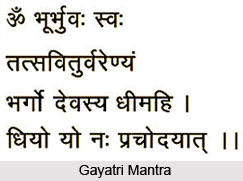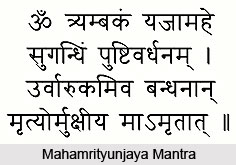 Types of Mantras include those that vary with their pronunciation. These can either be monosyllabic or in verse form. Mantra is the powerful verse, which has a sound effect that heals mind and body and takes them to a higher level of consciousness, which ultimately lead to attain spiritualism. Mantra meditation is an ancient practice to achieve spiritualism. It can be attained by the way of chanting the different types of mantras during meditation.
Types of Mantras include those that vary with their pronunciation. These can either be monosyllabic or in verse form. Mantra is the powerful verse, which has a sound effect that heals mind and body and takes them to a higher level of consciousness, which ultimately lead to attain spiritualism. Mantra meditation is an ancient practice to achieve spiritualism. It can be attained by the way of chanting the different types of mantras during meditation.
Various Types of Mantras
There are two types of mantras depending upon their pronunciation. They are monosyllabic and verse. The mantra in which one syllable is used is called Monosyllabic Mantra like Bija Mantras. When more than 60 syllables are used in a mantra it is called Verse Mantra like Gayatri Mantra.
On the basis of meanings, mantras are divided into Saguna Mantras (mantras that signify a specific God or Goddess) and Nirguna Mantras (mantras that are formless and conceptual representing the whole universe). On the basis of quality, the different types of mantras are Sattvic Mantras, Rajasic Mantras and Tamasic Mantras.
 Some of the various types of Mantras in Hinduism are mentioned below:
Some of the various types of Mantras in Hinduism are mentioned below:
•Gayatri Mantra: The Gayatri Mantra is a highly venerated mantra in Hinduism. This mantra is found in all four Vedas. Gayatri mantra is also considered as the heavenly awakening of mind and soul. It is the way of reaching most supreme form of survival and the way to be unified with the ultimate supreme power the `Brahman`. The Gayatri Mantra is considered by many as the most powerful way to attain God. Traditionally Gayatri Mantra is chanted everyday to develop intelligence, knowledge and wisdom and to expand the consciousness.
•Om Mantra: The Om Mantra is among the most significant mantras in Hinduism. "Om" is considered as the amalgamation of all mantras, that ultimately leads to an enlighten state of realisation. Mental repetition is the strongest way for Om Mantra, if the mind is steady and free from other thoughts.
•Maha Mrityunjaya Mantra: Maha Mrityunjaya Mantra is one of the most effective ancient Sanskrit mantras. This mantra is considered as a call for enlightenment and is a practice of cleansing the karmas of the essence at a deep level. The mantra is also said to be quite useful for mental, emotional and physical well-being. This mantra is dedicated to Lord Shiva. The mantra is:
"Om Tryambakam Yajamahe Sugandhim Pushtivardhanam Urvarukamiva Bandhanan Mrityor Mukshiya Maamritat".
There is a literal meaning for each word. The Maha Mrityunjaya Mantra brings the personal well being of the devotees around.
 Other Mantras
Other Mantras
There are other mantras that are also important in Hinduism. They are as follows:
•Maha Mantra for Lord Krishna is:"Hare Rama Hare Rama Rama Rama Hare Hare Hare Krishna Hare Krishna Krishna Krishna Hare Hare`
•Mantras for Lord Krishna are: Om Namo Bhagavate Vasudevaya, Om Sri Krishnaya Govindaya Gopijana Vallabhaya Namah, Om Sri Krishnaya Namah
•Mantra for Sri Devi is: Om Sri Durgayai Namah
•Lord Ganapati Mantra is: Om Sri Ganapataye Namah
•Sri Hanuman Mantra: Om Sri Hanumate Namah
•Mantra for Lord Hari: Om Namo Narayanaya, Hari Om, Hari Om Tat Sat
•Jugal (Combined) Mantras are: Sita Ram, Radhe Shyam, Radhe Krishna
•Sri Kalika Mantra is: Om Sri Kalikayai Namah
•Sri Laxmi Mantra:Om Sri Maha-Lakshmyai Namah
•Mantra for Lord Shiva: Maha Mrityunjaya Mantra and Om Namah Shivaya
•Mantras for Lord Rama are: Om Sri Ram Jaya Ram Jaya Jaya Ram, Om Sri Ramaya Namah, Sri Rama Rama Rameti, Rame Rame Manorame, Sahasranama Tattulyam Rama Nama Varanane, Om Sri Sita-Ramachandradhyam Namah, Sri Ram, etc.
•Sri Saraswati Mantra is: Om Sri Sarasvatyai Namah
•Kartikeya Mantra:Om Sri Saravanabhavaya Namah
•Sharangati Mantra (for surrender): Om Sri Ramah Sharanam Mama, Om Sri Krishnah Sharanam Mama, Om Sri Sita-Ramah Sharanam Mama
•Sharada Mantra is: Om Sri Bala-Parameshvaryai Namah
•Tripura Sundari Mantra is: Om Sri Tripura-Sundaryai Namah




















